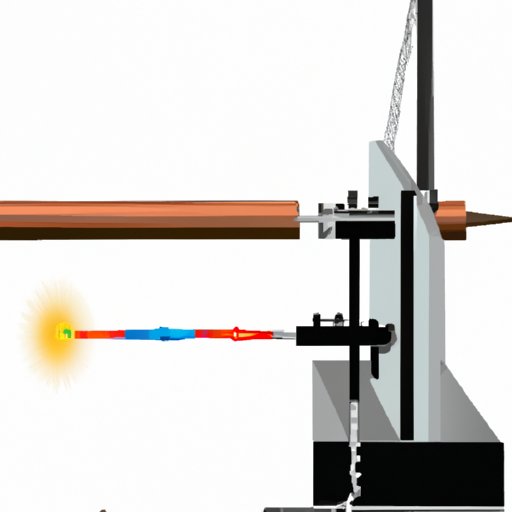Introduction
Railgun technology is an emerging weapon technology that utilizes electromagnetic forces to accelerate projectiles to extremely high speeds. This article will explore how a railgun works, from the basics of its components to the physics behind its operation. It will also examine the applications of this weapon technology and its advantages and disadvantages.
Explaining the Basics of Railgun Technology
A railgun is composed of three main components: two parallel rails, an armature, and a power supply. The two rails are connected to a power supply which creates an electric current between them. The armature is a metal plate that is placed between the two rails, and it is connected to a projectile which is to be fired. When the electric current passes through the rails, it generates a strong electromagnetic force which pushes the armature and projectile forward.
The electric current produces a magnetic field in the space between the rails, and this field interacts with the magnetic field created by the armature. This interaction creates a Lorentz force which accelerates the armature and projectile along the length of the rails.

Examining the Physics Behind the Operation of a Railgun
In order to understand how a railgun works, it is important to first understand the physics behind it. The operation of a railgun is based on Newton’s Laws of Motion and the Electromagnetic Force.
According to Newton’s First Law of Motion, a body will remain at rest or in uniform motion in a straight line unless acted upon by an external force. This law states that when an object is acted upon by an unbalanced force, it will experience acceleration. The Electromagnetic Force is the force that acts upon the armature and projectile when a railgun is fired.
The Electromagnetic Force is a combination of the electric and magnetic forces, and it is responsible for the acceleration of the armature and projectile. When an electric current passes through the rails, it creates a magnetic field in the space between the rails. This magnetic field interacts with the magnetic field created by the armature, and this interaction creates a Lorentz Force which accelerates the armature and projectile along the length of the rails.

Describing the Process of Accelerating a Projectile with a Railgun
A railgun firing cycle begins when the power supply is activated and an electric current is passed through the rails. This electric current creates a magnetic field in the space between the rails, and this field interacts with the magnetic field created by the armature. This interaction creates a Lorentz Force which accelerates the armature and projectile along the length of the rails.
As the projectile is accelerated, the electromagnetic force increases in strength and the projectile reaches higher and higher speeds. The projectile is eventually released from the rails and continues on its trajectory, propelled by the momentum gained from the acceleration process.

Analyzing the Applications of Railgun Technology
Railgun technology has a number of potential applications, including military, space exploration, and industrial uses. Compared to other weapon technologies, railguns have several advantages. For example, they can fire projectiles at much higher speeds than traditional weapons, and they do not require explosives, which makes them safer and more cost-effective. Additionally, railguns can fire multiple shots in quick succession, which allows for greater accuracy and faster response times.
However, there are also some drawbacks to using railguns. For example, they require a large amount of energy to operate, and the projectiles must be replaced after each use. Additionally, the projectiles can only travel a limited distance before losing their momentum, making them less effective over long ranges.
Conclusion
This article explored how a railgun works, from the basics of its components to the physics behind its operation. It also examined the applications of this weapon technology and its advantages and disadvantages. Railgun technology is an innovative weapon technology with a number of potential applications, but it also has some limitations that should be taken into account when deciding whether or not to use it.
Overall, railgun technology has the potential to revolutionize the way we think about weapon systems, and further research and development could lead to even more advanced and efficient applications of this technology.
(Note: Is this article not meeting your expectations? Do you have knowledge or insights to share? Unlock new opportunities and expand your reach by joining our authors team. Click Registration to join us and share your expertise with our readers.)
